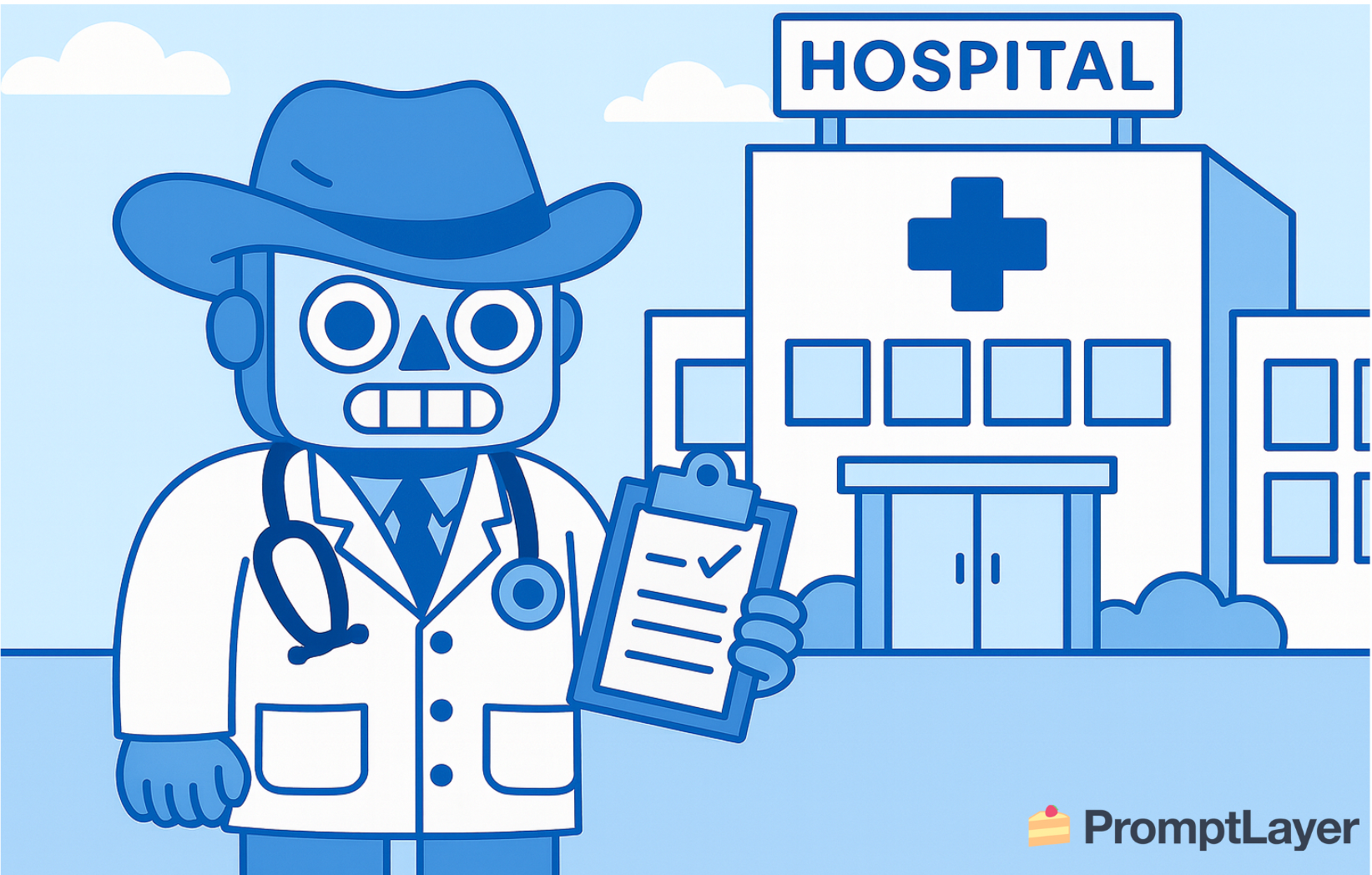Agentic Reasoning AI Doctor: Autonomous Reasoning Meets Modern Healthcare

The landscape of AI in healthcare is undergoing a fundamental transformation. We're witnessing a shift from simple pattern-matching chatbots that merely identify symptoms to sophisticated goal-directed "AI doctors" capable of reasoning through complex medical scenarios. This evolution represents a potential solution to healthcare's most pressing challenges: scalability constraints, the need for truly personalized care, and healthcare systems still strained in the post-pandemic era.
From Pattern Recognition to Agency
Traditional vs. Agentic AI
Traditional healthcare AI simply matches symptoms to conditions (like "headache plus fever equals possible flu"), while agentic AI operates through sophisticated plan-evaluate-act loops that actively weigh options, order tests, and create comprehensive follow-up plans tailored to each patient's unique medical context.
The Patient Experience
Where conventional symptom checkers provide static lists of 15 possible conditions and leave patients to determine next steps, agentic AI doctors examine complete medical histories, propose specific diagnostic tests, schedule follow-ups, and continuously adjust recommendations as new data becomes available, creating dynamic care pathways that evolve with the patient's condition.
Real-World Impact
Rather than just identifying a fracture on an X-ray, agentic systems deliver complete care plans that include immediate immobilization recommendations, scheduled orthopedic consultations, appropriate pain management prescriptions, and automated follow-up imaging reminders, providing patients with clear, sequential actions and personalized explanations instead of leaving them with mere diagnostic possibilities.
Real-World Deployments & Momentum
Agentic AI is moving rapidly from concept to clinical reality. Doctronic, a NYC-based startup, exemplifies this transition with its AI-powered primary care service. The platform conducts virtual symptom checkups, leverages current medical research, and maintains comprehensive patient histories to deliver rapid, personalized advice. With millions of users already engaged, Doctronic demonstrates how agentic reasoning can scale routine care while improving access. The system even proactively schedules follow-ups and sends reminders, ensuring continuity of care.
Quadrivia's "Qu" represents another approach, emphasizing safety-first deployment. Currently in clinical trials using standardized case vignettes, Qu undergoes rigorous testing where AI-versus-human simulations are scored on data gathering, management accuracy, and diagnostic precision. The team won't proceed to live deployment until meeting strict privacy regulations and medical device approvals under HIPAA/GDPR and FDA/MDR frameworks.
Beyond direct patient care, hospitals are piloting agentic agents for operational efficiency. According to a Workday industry report, major health IT leaders including Epic, ZoomCare, and IQVIA are pioneering solutions for scheduling, discharge planning, and billing automation. These AI agents proactively coordinate care teams and manage appointments without manual handoffs, addressing critical workflow bottlenecks.
The momentum is undeniable, at HIMSS 2025, agentic agents emerged as a top talking point among healthcare leaders, who recognize their potential to help strained systems meet surging demand. Investment in these technologies is expected to multiply as pilot programs demonstrate tangible benefits.
Safety Challenges
Agentic AI doctors present significant safety challenges that require careful management, including their tendency to generate plausible but false medical information through hallucinations and fabricated guidance, while expressing dangerous overconfidence even when providing incorrect answers and failing to recognize their knowledge limitations. These systems may perpetuate healthcare disparities through bias amplification when trained on underrepresentative datasets, potentially providing less accurate or harmful recommendations for certain populations, while also risking scope creep by exceeding intended functions and attempting unauthorized treatment decisions or prescriptions. Additionally, AI doctors must navigate strict privacy and security requirements under HIPAA and GDPR when handling sensitive health data, where breaches or improper data use could have severe consequences for patients and providers alike.
Evaluating Agentic AI Doctors: A Multi-Layered Approach
Assessing AI doctors requires sophisticated testing frameworks that go beyond traditional accuracy metrics to evaluate real-world clinical performance. Comprehensive evaluation systems are essential for ensuring patient safety and diagnostic reliability.
Key Evaluation Methods:
- Static QA Benchmarks: MultiMedQA combines USMLE-style questions with real patient queries to measure factual accuracy and clinical reasoning
- Interactive Agent Testing: AgentClinic simulates realistic clinical workflows where AI doctors conduct patient histories, order tests, and diagnose through multi-turn dialogues
- Clinical Vignette Scoring: Trained clinicians evaluate AI outputs on standardized patient cases, rating data gathering and treatment plan quality
- Continuous Expert Review: Ongoing assessment identifies performance gaps and areas needing improvement in real-time clinical scenarios
- Post-Deployment Quality Assurance: Regression logging continuously tests historical cases to prevent performance degradation, with automated alerts for quality deviations
Architecting Trustworthy AI Doctors
Building reliable AI doctors requires sophisticated system design with multiple safety layers, including modular architectures that split agents into clear components, Perception for data ingestion, Reasoning for decision logic, Dialogue for interaction, Memory for patient history, and Tools for actions, enabling targeted testing of each component while mirroring healthcare team structures. Critical safety mechanisms include retrieval-augmented knowledge systems that connect to trusted medical databases at runtime to minimize hallucinations and allow source citation, patient-level memory that maintains comprehensive charts with previous diagnoses, medications, and allergies to prevent critical errors, and human-in-the-loop gates with confidence thresholds that automatically defer to clinicians when uncertainty exceeds preset limits. Additional protective measures include comprehensive audit logs with timestamps and prompt versions for debugging and regulatory compliance, plus hard-coded safety rules that provide fail-safe protection by blocking dangerous drug interactions regardless of AI recommendations.
Compliance Landscape
AI doctors must navigate complex regulatory requirements across jurisdictions, including FDA Software-as-a-Medical-Device pathways in the U.S. that require clearance through 510(k), De Novo, or PMA processes with Predetermined Change Control Plans for continuously learning systems, WHO guidelines emphasizing transparency and collaborative risk management throughout the AI lifecycle, and EU AI Act plus Medical Device Regulation requirements that classify healthcare AI as "high-risk" while mandating detailed data governance, post-market monitoring, and CE marking for medical software. Global regulators from Singapore's Health Sciences Authority to Canada's Health Canada are establishing AI-specific frameworks with the universal theme of rigorous validation and continuous post-market monitoring to ensure patient safety and system reliability.
Managing Healthcare AI with PromptLayer
PromptLayer offers comprehensive capabilities for creating, evaluating, and managing agentic AI systems in healthcare environments through its specialized prompt and agent engineering platform. The platform provides essential governance tools including version-controlled prompt management with instant rollback capabilities for debugging and compliance reporting, automated evaluation pipelines that enable A/B testing of different clinical strategies and regression testing on medical scenario libraries to ensure performance improvements, and observability dashboards that allow non-technical stakeholders to examine AI reasoning and decision trees through intuitive interfaces. Additionally, PromptLayer's collaboration features enable clinical experts to directly refine AI language and constraints through visual editors without coding expertise, democratizing the maintenance process and allowing medical professionals to improve AI phrasing and clinical guidance based on established best practices.
Conclusion
Agentic AI represents a paradigm shift in healthcare delivery, from reactive pattern matching to proactive, personalized care orchestration. These systems promise unprecedented scalability and accessibility, potentially addressing healthcare's most pressing challenges. However, the stakes couldn't be higher. Patient safety demands that we combine robust architectural design, rigorous evaluation frameworks, and strict regulatory alignment.
The path forward requires continued collaboration between technologists, clinicians, and regulators. As safety tooling matures and standards solidify, we can expect wider adoption of these transformative technologies. The future of healthcare may well depend on our ability to harness agentic AI's potential while maintaining the trust and safety that patients deserve.
The question is how quickly we can build the frameworks to deploy them safely and effectively. With careful development and appropriate oversight, agentic AI doctors could help create a healthcare system that's more accessible, efficient, and personalized than ever before.
PromptLayer is an end-to-end prompt engineering workbench for versioning, logging, and evals. Engineers and subject-matter-experts team up on the platform to build and scale production ready AI agents.
Made in NYC 🗽
Sign up for free at www.promptlayer.com 🍰



